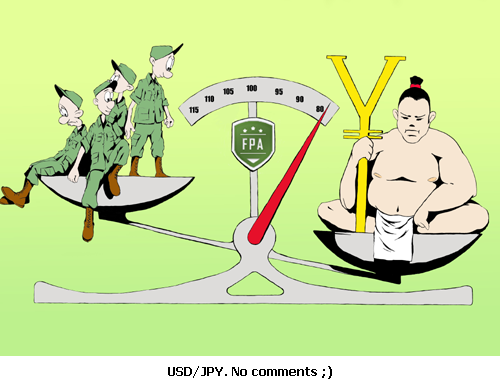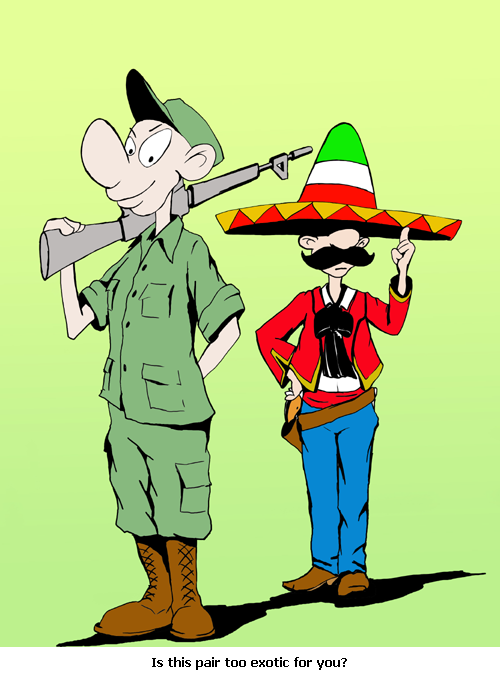Commander in Pips: Well, the whole system of quoting prices is very simple. Currencies are traded in pairs. All possible pairs have already been created and available for trading. Other words, you will trade not a separate currency, but the pair and the quote is an exchange rate one currency to another.
Commander in Pips: For simplicity, let’s skip separate quoting for buy and sell (we will talk about it a bit later), and use just the first column - what does it mean?

Commander in Pips: Outstanding! That’s an excellent association. I see that you’re starting to have a real knack for all this stuff.
Now to your second question about “all possible pairs”. Here are three currencies – GBP, USD and EUR. How many pairs can you create with them?

Commander in Pips: During recent times, the economies of emerging markets have becomes stronger, the trading turnover is rising, so on FOREX markets, there is more demand appeared for exchanging emerging market’s currencies as between themselves and with major currencies. For example, now we can trade on FOREX such currencies as Brazilian real, South Africa’s rand, Mexican peso, Thai baht, Russian Ruble, Singaporean dollar, Chinese Yuan, etc. Usually they are traded to US Dollar and sometimes with other major currencies. Occasionally, they are traded with each other. There is much will depend from your FOREX broker, because not all of them provide the possibility to trade exotic pairs or even their crosses. But, in general, these pairs exist and can be traded. Here are some examples of them:
Due to lower size on economies of Emerging markets and their international Trade turnover, the trading volumes with exotic pairs is lower compared to majors and crosses. Besides, the transaction cost for trading them is usually higher.
See – there is a double quoting, one price is for buying the foreign currency and another for selling it. The difference between buy and sell price calls “bid/ask spread”. If you will buy Euro here for 1.37 (because bank sells Euro for 1.37 currently, this is “Ask” price) and at once sell it at 1.35 (because bank buys Euro only for 1.35, this is “Bid” price) you will get a $0.02 loss – that’s your transaction cost. In fact, you do nothing, because you stand with the same position - you Buy Euro and Sell Euro at the same time. Even so, you’ve just lost 2 cents. So, for major pairs the Bid/Ask spread on FOREX is very tight - usually 0.0001-0.0003, but for exotic pairs it’s much wider. It means that if you would like to make the same transaction with Thai baht, for example, you can get greater loss instead of 2 cents as it stands with Euro transaction. It can be 50 cents or even buck. You should remember that if you ever intend to trade exotic pairs. We’ve just talked about Bid/Ask spread but there are other sorts of transaction costs that exist also.
Commander in Pips: Ok, imagine looking at a bank’s currency exchange center. What do you see on a quote board?Pipruit: Wait a minute, what do you mean by “in pairs” and by “all possible pairs”?
Pipruit: Yesterday, I remember seeing something like this:
Currency | We Buy at | We Sell at |
1 EUR | 1.35 USD | 1.37 USD |
1 GBP | 1.65 USD | 1.67 USD |
Commander in Pips: For simplicity, let’s skip separate quoting for buy and sell (we will talk about it a bit later), and use just the first column - what does it mean?
Currency | USD |
1 EUR | 1.35 |
1 GBP | 1.65 |
Commander in Pips: So that is the answer – GBP/USD and EUR/USD are currency pairs. When you make a transaction on FOREX you’re simultaneously buying one currency and selling another. For example, buying EUR/USD means Buy EUR and Sell USD. The first placed currency shows what are you buying or selling, and second one shows what you’re getting instead. Selling EUR/USD means that you‘re selling EUR and buying, i.e. “getting instead” USD.Pipruit: Oh, it’s quite simple – I can exchange 1 GBP for 1.65 USD and 1 EUR for 1.35 USD
Pipruit: When you’re explaining that, I have an association with pair of scales. On the one scale is the first currency, say EUR, on the other one is USD. And exchanging rate, i.e. equilibrium is fluctuating all the time, based on which currency is getting stronger right now.

Commander in Pips: Outstanding! That’s an excellent association. I see that you’re starting to have a real knack for all this stuff.
Now to your second question about “all possible pairs”. Here are three currencies – GBP, USD and EUR. How many pairs can you create with them?
Your banner here
Commander in Pips: Very good! Indeed, FOREX does not have both EUR/USD and USD/EUR pairs simultaneously. This is because they are, in fact, identical. Ok, let’s add one more currency, say, CAD. What pairs can you create now?Pipruit: Let’s see… we already know pairs like USD/USD or EUR/EUR do not make any sense, so I suppose that we can create only three pairs – EUR/USD, GBP/USD and EUR/GBP. Also we can make reverse pairs, such as USD/EUR, for example, but this will be the same pair as EUR/USD. The only difference will be that it will show how many Euros I should pay for 1 buck, instead of initially how much bucks I should pay for 1 EUR. If, for example EUR/USD rate is 1.35, then USD/EUR is 1/1.35 or about 0.74. It means that I should pay about 0.74 EUR for 1 buck.
Commander in Pips: Right you are. So, do you understand now, what I mean with “all possible pairs”?Pipruit: It’s a simple task. I just have to add just pairs that include CAD. EUR/USD, GBP/USD and EUR/GBP we have already, so I need to add USD/CAD, EUR/CAD and GBP/CAD.
Commander in Pips: There are a lot of pairs. Generally speaking, all pairs can be put into one of three groups – Majors, Crosses and Exotic.Pipruit: Yes sir, now it looks clear. But how many pairs exist in total? And are there any differences with trading them?
Commander in Pips: Not quite. We’ve talked about “Major currencies” and now we’re discussing “Major pairs”. It’s not exactly the same.Pipruit: Yes, we’ve talked about Majors previously. They are USD, EUR, GBP, CAD, JPY, AUD and NZD.
Commander in Pips:Pipruit: What’s the difference, sir?
- 1. All major pairs include the US Dollar with another “Major currency”. These have a leading share in total turnover on the FOREX market. Here they are:
Pair
Countries
EUR/USD
Euro zone / United States
GBP/USD
United Kingdom / United States
USD/CHF
United States/ Switzerland
USD/JPY
United States / Japan
USD/CAD
United States / Canada
AUD/USD
Australia / United States
NZD/USD
New Zealand / United States
- Crosses are other combinations of “Major Currencies”. They include one major currency with another, but not with the US Dollar. You can construct them by yourself. I’ll just give you some examples. Euro crosses:
Pair
Countries
EUR/GBP
Euro zone / United States
EUR/CHF
Euro zone / Switzerland
EUR/CAD
Euro zone / Canada
EUR/AUD
Euro zone / Australia
EUR/NZD
Euro zone / New Zealan
or Japanese Yen crosses:
Pair | Countries |
EUR/JPY | Euro zone / Japan |
GBP/JPY | United Kingdom / Japan |
CHF/JPY | Switzerland / Japan |
USD/JPY | United States / Japan |
CAD/JPY | Canada / Japan |
AUD/JPY | Australia / Japan |
NZD/JPY | New Zealand / Japan |
Pipruit: Ok, Ok, I think I understand that. And what are exotic pairs?

Commander in Pips: During recent times, the economies of emerging markets have becomes stronger, the trading turnover is rising, so on FOREX markets, there is more demand appeared for exchanging emerging market’s currencies as between themselves and with major currencies. For example, now we can trade on FOREX such currencies as Brazilian real, South Africa’s rand, Mexican peso, Thai baht, Russian Ruble, Singaporean dollar, Chinese Yuan, etc. Usually they are traded to US Dollar and sometimes with other major currencies. Occasionally, they are traded with each other. There is much will depend from your FOREX broker, because not all of them provide the possibility to trade exotic pairs or even their crosses. But, in general, these pairs exist and can be traded. Here are some examples of them:
Pair | Countries |
USD/HKD | United States (dollar)/ Hong Kong (dollar) |
USD/SGD | United States (dollar) / Singapore (dollar) |
USD/ZAR | United States (dollar) / South Africa (rand) |
USD/THB | United States (dollar) / Thailand (baht) |
USD/MXN | United States (dollar) / Mexico (peso) |
USD/DKK | United States (dollar) / Denmark (Krone) |
USD/SEK | United States (dollar) / Sweden (Kronor) |
USD/NOK | United States (dollar) / Norway (Krone) |
Due to lower size on economies of Emerging markets and their international Trade turnover, the trading volumes with exotic pairs is lower compared to majors and crosses. Besides, the transaction cost for trading them is usually higher.
Your banner here
Commander in Pips: Well, it’s a bit early to talk about that in detail, but I give you fast forward look. Let’s return to quote board in exchange centre:Pipruit: I understand about pairs, but what are transaction costs?
Currency | We Buy at | We Sell at |
1 EUR | 1.35 USD | 1.37 USD |
1 GBP | 1.65 USD | 1.67 USD |
See – there is a double quoting, one price is for buying the foreign currency and another for selling it. The difference between buy and sell price calls “bid/ask spread”. If you will buy Euro here for 1.37 (because bank sells Euro for 1.37 currently, this is “Ask” price) and at once sell it at 1.35 (because bank buys Euro only for 1.35, this is “Bid” price) you will get a $0.02 loss – that’s your transaction cost. In fact, you do nothing, because you stand with the same position - you Buy Euro and Sell Euro at the same time. Even so, you’ve just lost 2 cents. So, for major pairs the Bid/Ask spread on FOREX is very tight - usually 0.0001-0.0003, but for exotic pairs it’s much wider. It means that if you would like to make the same transaction with Thai baht, for example, you can get greater loss instead of 2 cents as it stands with Euro transaction. It can be 50 cents or even buck. You should remember that if you ever intend to trade exotic pairs. We’ve just talked about Bid/Ask spread but there are other sorts of transaction costs that exist also.
2 comments:
ugg uk, replica watches, moncler, moncler uk, karen millen uk, moncler, pandora jewelry, hollister, canada goose, juicy couture outlet, moncler outlet, juicy couture outlet, louis vuitton, moncler, montre pas cher, links of london, canada goose, toms shoes, supra shoes, louis vuitton, thomas sabo, canada goose uk, doudoune moncler, ugg,ugg australia,ugg italia, ugg, canada goose jackets, swarovski crystal, ugg,uggs,uggs canada, louis vuitton, pandora uk, moncler outlet, canada goose outlet, louis vuitton, marc jacobs, wedding dresses, moncler, canada goose outlet, swarovski, ugg pas cher, canada goose, pandora jewelry, coach outlet, canada goose outlet, louis vuitton, pandora charms
I certainly appreciate this website
http://www.kuwait.prokr.net/
http://www.emirates.prokr.net/
Post a Comment